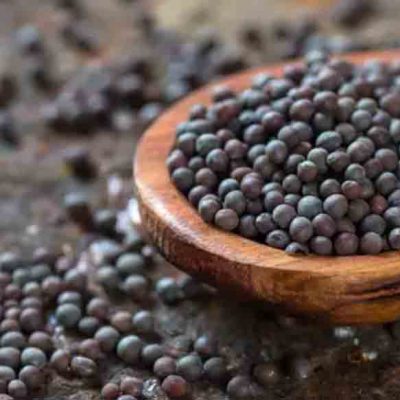Mustard
Introduction
It is considered an oil crop but is generally a healthy spice. It is rich in minerals, vitamins and antioxidants.

Mustard Cultivation
Mustard can be cultivated well in Dry and Intermediate zones of Sri Lanka. Well distributed 600-1000 mm of annual rainfall is favorable. However, heavy rains at any stage of the plant will adversely affect the plant growth and yield. Mustard is ideally suited for cultivation in new chenas and in home gardens too. Can be cultivated with irrigated conditions in Yala season and as rainfed in Maha season
Well fertile, well drained, lightly textured sandy loam soil is preferred. Good soil fertility is essential for obtaining good yield.
Land preparation with rains will improve water efficiency. Weeds and other uninfected crop debris should be incorporated to the soil by ploughing using a disk plough. Then fine tilth the soil using a harrower or rotovator and break large soil particles.
Properly prepare drainage lines to drain out excess water in the field and to avoid accumulation of water on the soil surface. Seed establishment in raised beds or ridges are suitable to facilitate drainage.
Seed requirement- 6-8 kg/ha
Spacing
If row seeding
30 cm between rows and 15 cm between the plants
Seed broadcasting or row seeding can be practiced. In favorable drainage conditions seed establishment can be done in flat beds and in poorly drained or irrigated conditions, row seeding in ridge and furrows can be practiced. Thin-out excess plants keeping the correct spacing after 2 weeks of planting and keep one plant per hill.
Seeds can be planted in April to May for Yala season and in late October to early November for Maha season.
Weeding 2-3 weeks after sowing by manually or using equipment is preferred. Weed management is easy when row seeding is practiced.
It is very important to have enough moisture in the soil until the seeds germinate. If there is not enough moisture in the soil, supply water at 5-7 days interval during first 4 weeks of planting and then water at least 10-14 days interval until seeds mature.
Organic fertilizers are very important to fertilize the soil. Apply well decomposed compost (1%N) at the rate of 2.3 t/ha or cattle manure at the rate of 1.5 t/ha at the land preparation or two days before seed establishment and mix with the soil. Then apply well decomposed compost (1%N) at the rate of 4.6 t/ha or cattle manure at the rate of 3 t/ha 3 weeks after planting and mix with the soil. Soil testing should be done every 3-4 seasons to identify soil nutrient status and other soil problems.
- Diamond back moth-(Plutella xylostella)
Whitish patches due to scrapping of epidermal leaf tissues by young larvae can be seen. Leaves wither and in later stage larva bore holes in the leaves.
Control
Weed management
Maintain a clean field
- Sucking bugs-Bagrada spp
The plants wilt. Black and orange colored bugs can be seen on the plant.
Control
Plant on time
Maintain a clean field
Pod harvesting is done manually several times since the pod maturity is staggered. Threshing can be done in bare feet or by tractor.
Use tarpaulin sheets to place seeds from the plants to avoid the contaminations. The seeds can be sun dried until 8% of moisture and store the seeds in polysack bags and keep in a dry and pest proof condition.
